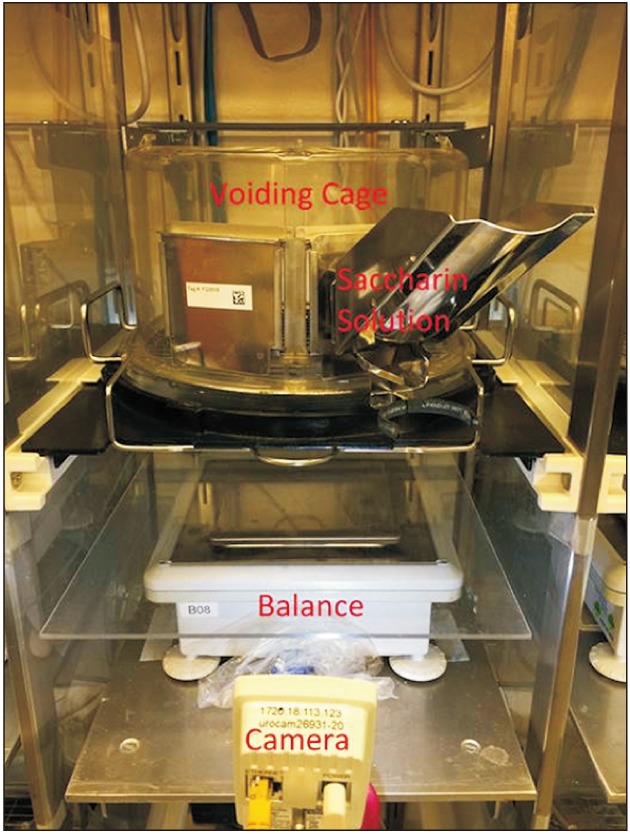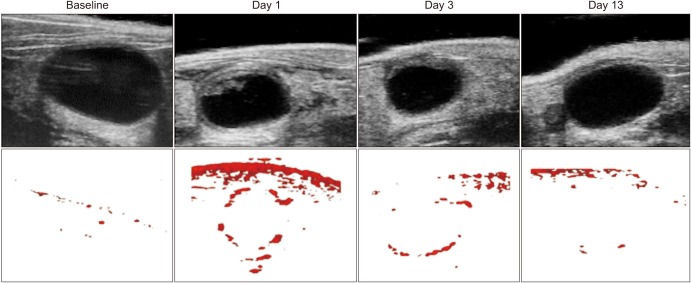Investig Clin Urol.
2020 Jan;61(1):75-80. 10.4111/icu.2020.61.1.75.
High-definition ultrasound characterization of acute cyclophosphamide-induced cystitis in the mouse
- Affiliations
-
- 1Department of Obstetrics and Gynecology, University of Texas Medical Branch, TX, USA. tolee@utmb.edu
- 2Department of Obstetrics and Gynecology, University of Rochester Medical Center, NY, USA.
- KMID: 2466795
- DOI: http://doi.org/10.4111/icu.2020.61.1.75
Abstract
- PURPOSE
To examine associations if any between changes in voiding function, hematuria, and bladder ultrasonography metrics in murine cyclophosphamide-induced chemical cystitis.
MATERIALS AND METHODS
Cystitis was induced in 6 female mice by an intraperitoneal injection of cyclophosphamide (300 mg/kg). Voiding frequency, void volume, hematuria assessment, and ultrasonographic measurements of the bladder were obtained at baseline, days 1 to 5, and days 9, 11, and 13. Voiding was induced with preferred sweet drinking solution and voiding data collected using an automated data collection system in 135 minute sessions. Bladder wall thickness, lumen volume, and vascular Doppler were acquired using a high definition ultrasound system. Spearman's correlation was used to analyze the association between the voiding changes, hematuria, and ultrasound findings.
RESULTS
Hematuria was present 24 hours after cyclophosphamide injection. All animals displayed increased bladder vascularity, bladder wall thickness, and void frequency that was associated with concurrent decreased total and average void volumes. Increased bladder wall vascularity was correlated with the presence of hematuria (r=0.59, p < 0.01) and bladder wall thickness (r=0.79, p < 0.01). Hematuria correlated with increased void frequency (r=0.34, p < 0.01). Average void volume was negatively correlated with hematuria (r=−0.50, p < 0.01) and frequency (r=−0.38, p < 0.01).
CONCLUSIONS
High-definition ultrasound imaging permits in vivo monitoring of changes in bladder morphology associated with voiding function in relation to cyclophosphamide-induced cystitis. Ultrasound imaging of the bladder may assist in differential diagnosis of bladder dysfunction.
Keyword
MeSH Terms
Figure
Reference
-
1. Berry SH, Elliott MN, Suttorp M, Bogart LM, Stoto MA, Eggers P, et al. Prevalence of symptoms of bladder pain syndrome/interstitial cystitis among adult females in the United States. J Urol. 2011; 186:540–544. PMID: 21683389.
Article2. Hanno PM, Burks DA, Clemens JQ, Dmochowski RR, Erickson D, Fitzgerald MP, et al. Interstitial Cystitis Guidelines Panel of the American Urological Association Education and Research, Inc. AUA guideline for the diagnosis and treatment of interstitial cystitis/bladder pain syndrome. J Urol. 2011; 185:2162–2170. PMID: 21497847.
Article3. Vasudevan V, Moldwin R. Addressing quality of life in the patient with interstitial cystitis/bladder pain syndrome. Asian J Urol. 2017; 4:50–54. PMID: 29264207.
Article4. Boucher M, Meen M, Codron JP, Coudore F, Kemeny JL, Eschalier A. Cyclophosphamide-induced cystitis in freely-moving conscious rats: behavioral approach to a new model of visceral pain. J Urol. 2000; 164:203–208. PMID: 10840460.
Article5. Edrees G, Luts A, Stewart F. Bladder damage in mice after combined treatment with cyclophosphamide and X-rays. The influence of timing and sequence. Radiother Oncol. 1988; 11:349–360. PMID: 3375461.
Article6. Stewart FA. Mechanism of bladder damage and repair after treatment with radiation and cytostatic drugs. Br J Cancer Suppl. 1986; 7:280–291. PMID: 3521706.7. Arnold H, Bourseaux F, Brock N. Chemotherapeutic action of a cyclic nitrogen mustard phosphamide ester (B 518-ASTA) in experimental tumours of the rat. Nature. 1958; 181:931. PMID: 13526741.
Article8. Rubin JS, Rubin RT. Cyclophosphamide hemorrhagic cystitis. J Urol. 1966; 96:313–316. PMID: 5953127.
Article9. Wood R, Eichel L, Messing EM, Schwarz E. Automated noninvasive measurement of cyclophosphamide-induced changes in murine voiding frequency and volume. J Urol. 2001; 165:653–659. PMID: 11176453.
Article10. Wood RW, Baggs RB, Schwarz EM, Messing EM. Initial observations of reduced uroflow in transgenic adenocarcinoma of murine prostate. Urology. 2006; 67:1324–1328. PMID: 16765198.
Article11. Nicholson TM, Ricke EA, Marker PC, Miano JM, Mayer RD, Timms BG, et al. Testosterone and 17β-estradiol induce glandular prostatic growth, bladder outlet obstruction, and voiding dysfunction in male mice. Endocrinology. 2012; 153:5556–5565. PMID: 22948219.
Article12. Nicholson TM, Nguyen JL, Leverson GE, Taylor JA, Vom Saal FS, Wood RW, et al. Endocrine disruptor bisphenol A is implicated in urinary voiding dysfunction in male mice. Am J Physiol Renal Physiol. 2018; 315:F1208–F1216. PMID: 30019933.
Article13. Nicholson TM, Moses MA, Uchtmann KS, Keil KP, Bjorling DE, Vezina CM, et al. Estrogen receptor-α is a key mediator and therapeutic target for bladder complications of benign prostatic hyperplasia. J Urol. 2015; 193:722–729. PMID: 25167991.
Article14. Valenstein ES, Cox VC, Kakolewski JW. Polydipsia elicited by the synergistic action of a saccharin and glucose solution. Science. 1967; 157:552–554. PMID: 6028919.
Article15. Datta K, Chin A, Ahmed T, Qing WG, Powell KL, Simhambhatla P, et al. Mixed effects of 2,6-dithiopurine against cyclophosphamide mediated bladder and lung toxicity in mice. Toxicology. 1998; 125:1–11. PMID: 9585095.
Article16. Bjorling DE, Elkahwaji JE, Bushman W, Janda LM, Boldon K, Hopkins WJ, et al. Acute acrolein-induced cystitis in mice. BJU Int. 2007; 99:1523–1529. PMID: 17346276.
Article17. Wu SY, Jhang JF, Jiang YH, Kuo HC. Increased bladder wall thickness is associated with severe symptoms and reduced bladder capacity in patients with bladder pain syndrome. Urol Sci. 2016; 27:263–268.
Article18. Pontari MA, Hanno PM, Ruggieri MR. Comparison of bladder blood flow in patients with and without interstitial cystitis. J Urol. 1999; 162:330–334. PMID: 10411032.
Article19. Golubeva AV, Zhdanov AV, Mallel G, Dinan TG, Cryan JF. The mouse cyclophosphamide model of bladder pain syndrome: tissue characterization, immune profiling, and relationship to metabotropic glutamate receptors. Physiol Rep. 2014; 2:e00260. PMID: 24760514.
Article20. Ali MM, Ahmed AF, Khaled SM, Abozeid H, AbdelMagid ME. Accuracy of ultrasound-measured bladder wall thickness for the diagnosis of detrusor overactivity. Afr J Urol. 2015; 21:25–29.
Article
- Full Text Links
- Actions
-
Cited
- CITED
-
- Close
- Share
- Similar articles
-
- Chronic Cyclophosphamide Induced Cystitis that is Improved by Mesna
- Expressions of Uroplakins in the Mouse Urinary Bladder with Cyclophosphamide-Induced Cystitis
- Cyclophosphamide-Induced Hemorrhagic Cystitis in Acute Lymphocytic Leukemia and Non-Hodgkin Lymphoma
- Characterization of the expression of cytokeratins 5, 8, and 14 in mouse thymic epithelial cells during thymus regeneration following acute thymic involution
- A case of systemic lupus erythematosus with chylothorax, chronic interstitial cystitis and protein-losing enteropathy



